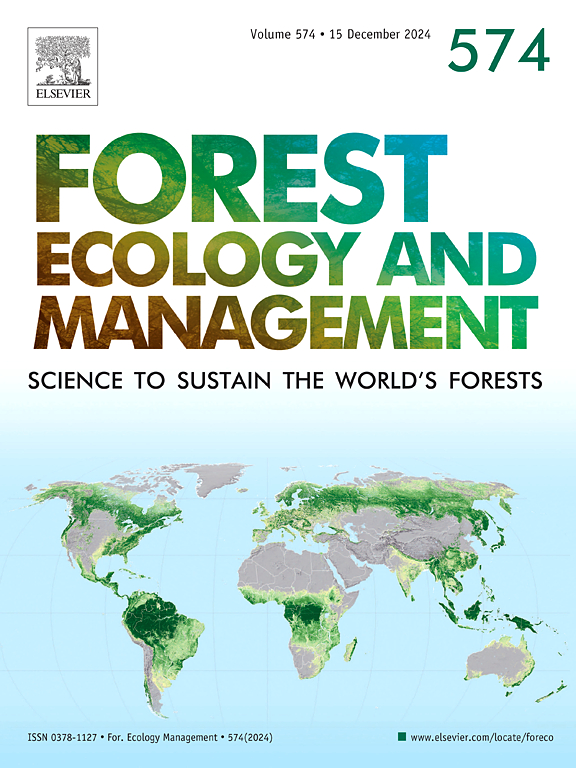Cross-scale patterns of structure and maximum biomass in late-seral Douglas-fir-dominated rainforests
IF 3.7
2区 农林科学
Q1 FORESTRY
引用次数: 0
Abstract
This study of late-seral Douglas-fir forests in coastal Washington examined scales from 0.1 to 65–80 ha to quantify persistence of the Douglas-fir overstory and patterns of aboveground biomass (henceforth biomass) distribution. Plot-based biomass estimates were scaled from 0.1–1 ha via tree-level allometry in four forests with Douglas-fir 180–600 yr old. At the 0.1 ha scale, biomass ranged from 69–2905 Mg ha−1 live and 12–792 Mg ha−1 dead with magnitude and spatial variability increasing with dominant tree age. Some 0.1 ha areas had > 2000 Mg ha−1 live Douglas-fir alone. Our 1–3 ha plots held 1100–1700 Mg ha−1 biomass with Douglas-fir always accounting for > 70 % of live biomass and > 46 % of crown volume despite having only 23 trees ha−1 when trees exceeded 500 yr old. Dead biomass in plots ranged from 10–25 % of the total with 50–85 % being Douglas-fir. A segmented canopy height model from airborne laser scanning (i.e., ALS segments) was mapped to 191 measured trees to create an allometric equation for predicting live biomass. This equation was applied to all ALS segments across 288 ha of forest with dominant trees ranging from 340–620 yr old. Within plot boundaries, ALS-predicted live tree biomass errors ranged from 10–23 %. At 65–80 ha spatial scales, patterns of biomass revealed a breakup of high-biomass forest into aggregations of < 1-ha patches. The largest trees (> 50 Mg) were associated with high-biomass areas when Douglas-fir were younger, but beyond 500 yr, such elite trees increasingly occurred in relatively low-biomass areas. Estimated live tree biomass ranged from 112–1600 Mg ha−1 with median values decreasing with Douglas-fir age from ∼900 Mg ha−1 at 350 yr to ∼600 Mg ha−1 at 600 yr. In Douglas-fir-dominated rainforests, restoration management can promote long-lived high-biomass forests and arboreal biodiversity through actions that enhance development of elite trees across all overstory age cohorts, emulating patterns of biomass distribution observed here.
求助全文
约1分钟内获得全文
求助全文
来源期刊

Forest Ecology and Management
农林科学-林学
CiteScore
7.50
自引率
10.80%
发文量
665
审稿时长
39 days
期刊介绍:
Forest Ecology and Management publishes scientific articles linking forest ecology with forest management, focusing on the application of biological, ecological and social knowledge to the management and conservation of plantations and natural forests. The scope of the journal includes all forest ecosystems of the world.
A peer-review process ensures the quality and international interest of the manuscripts accepted for publication. The journal encourages communication between scientists in disparate fields who share a common interest in ecology and forest management, bridging the gap between research workers and forest managers.
We encourage submission of papers that will have the strongest interest and value to the Journal''s international readership. Some key features of papers with strong interest include:
1. Clear connections between the ecology and management of forests;
2. Novel ideas or approaches to important challenges in forest ecology and management;
3. Studies that address a population of interest beyond the scale of single research sites, Three key points in the design of forest experiments, Forest Ecology and Management 255 (2008) 2022-2023);
4. Review Articles on timely, important topics. Authors are welcome to contact one of the editors to discuss the suitability of a potential review manuscript.
The Journal encourages proposals for special issues examining important areas of forest ecology and management. Potential guest editors should contact any of the Editors to begin discussions about topics, potential papers, and other details.
 求助内容:
求助内容: 应助结果提醒方式:
应助结果提醒方式:


